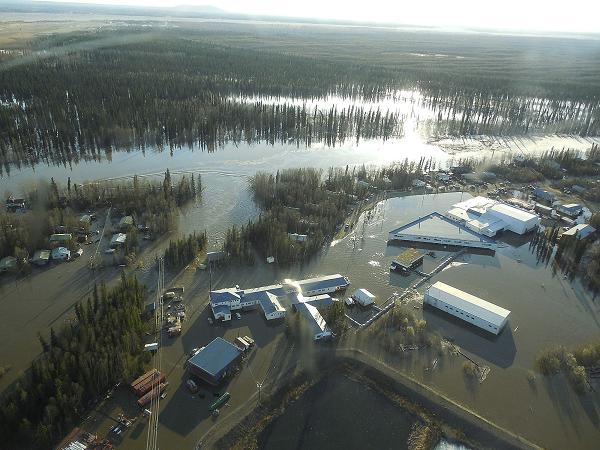Flooding continues in Galena, Alaska

Flooding in Galena continues for the third straight day, but hints that the ice jam may finally break are surfacing, as the town of Koyukuk downriver prepares for possible flooding.
The ice jam located 20 miles downstream of the Interior town of Galena, population 470, has held in place since late Sunday night, at an “S” curve notorious for creating blockages. Even as Interior temperatures hit the 70s, the jam has remained, causing widespread flooding and an evacuation of most of the community’s residents.
Almost every structure in Galena is flooded. As of Wednesday afternoon, the water levels still remain high, said Ed Plumb, hydrologist with the National Weather Service.
“A handful of houses have water over the rooftops,” Plumb said. One bed-and-breakfast has ice and water up to the rooftop, and has been pushed off its foundation into the river, and may get carried away with the ice once the water starts moving again. The airport is the only dry patch in town, protected by dikes. Plumb has been camping out at the airport since Monday, his belongings stranded at a flooded B&B.
Continuous flooding for three days has caused the water to span the entire valley, about 25 miles wide. “It’s flooded the area all the way to the hills on both sides,” Plumb said.
People are using boats to get around, and dogs that were unable to evacuate with their owners are wandering around town, Plumb said. Fuel tanks have been knocked down and leaked into the water, and a strong smell of fuel is noticeable at the airport. The sewage lagoon has also been affected.
Galena still lacks power and water. “People are just kind of making due,” Plumb said.
Tanana Chiefs Conference (TCC), a tribal organization, reported that there were 76 people taking shelter in Galena, at the school and old military dorms. The TCC has evacuated 256, mostly to Fairbanks and Anchorage. The Alaska Division of Homeland Security and Emergency Management will be reimbursing TCC for the evacuation costs.
Both the Alaska Air National Guard and Army National Guard were called out to Galena Tuesday evening during a brief scare when the water rose up past the airport’s dike walls, potentially blocking the community’s only escape route. The Air National Guard evacuated 32 people and 19 dogs, and the Army National Guard evacuated six people.
Others have been evacuated by private aircraft; a complete count of the evacuees is unknown.
The American Red Cross is providing support for more than 200 residents being sheltered in Fairbanks and Anchorage.
There are signs that the ice jam may break soon; an open patch of water in from of the dam is “chewing away at the ice,” Plumb said, and some water is flowing past the ice jam. Some ice has also been spotted flowing downriver past the jam.
Once the ice jam does break up and water levels recede, the town can begin picking up the pieces. Roads have washed out, houses are off their foundations and the state of the power plants and water tank pipes are unknown.
Even then, “it will take the water a long time to drain,” perhaps weeks in low lying areas, Plumb said.
Warnings downriver
Now, the village of Koyukuk, downriver from Galena and home to fewer than 100 people, is on flood warning as the ice jam will start heading their way once it breaks in Galena.
“Koyukuk is very spun up, watching the jam intently,” said Alaska Homeland Security spokesman Jeremy Zidek.
Koyukuk resident Benedict Jones, who was born in the tiny speck of a village, said Wednesday afternoon that conditions were “still safe, so far.” The village’s elders evacuated and went to Fairbanks Tuesday night; children may be evacuated once the ice jam upriver breaks, he said.
Others in the village have placed belongings in boats for when the jam crumbles, spilling a wall of water downriver. They also drove their snowmachines to higher ground, Jones said. Most buildings in the community are elevated four feet, a precaution residents took after a handful of previous floods. Jones recalled four prior floods, including one in 1937, when he was just four years old.
“Now, we’re always prepared for floods,” he said. “If we feel we need to move away from the village, we’ll go up to the rock quarry, two miles from the village.”
Residents can only prepare so much, he added.
Gov. Sean Parnell’s senior staff met Wednesday to discuss whether to declare a disaster in Galena, Zidek said. If a disaster declaration is made, Homeland Security will make funding available to help local government, private businesses and individuals repair damage caused by the flood.
If the damage is “bad enough” Parnell could ask for federal assistance, provided by Homeland Security and the Federal Emergency Management Agency (FEMA), Zidek said.
Contact Laurel Andrews at laurel(at)alaskadispatch.com. Reporter Jerzy Shedlock also contributed to this report.



